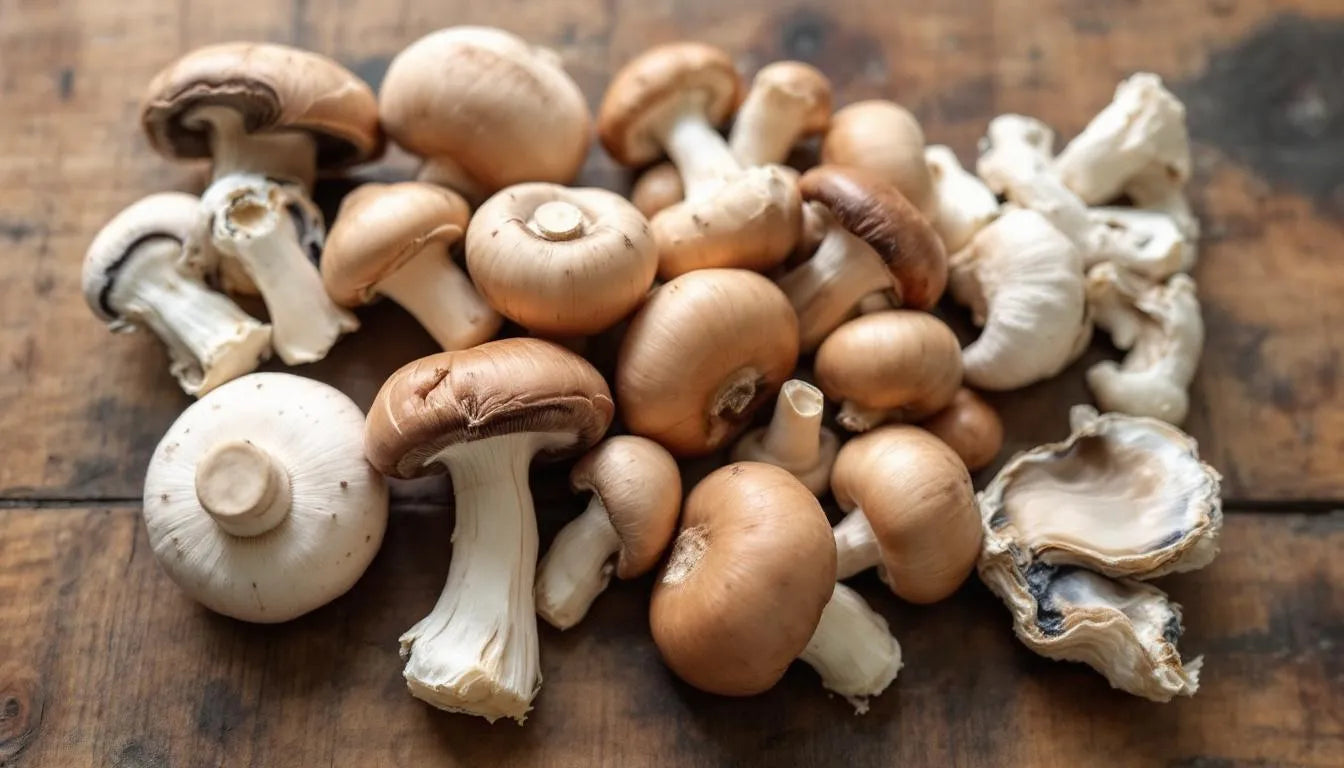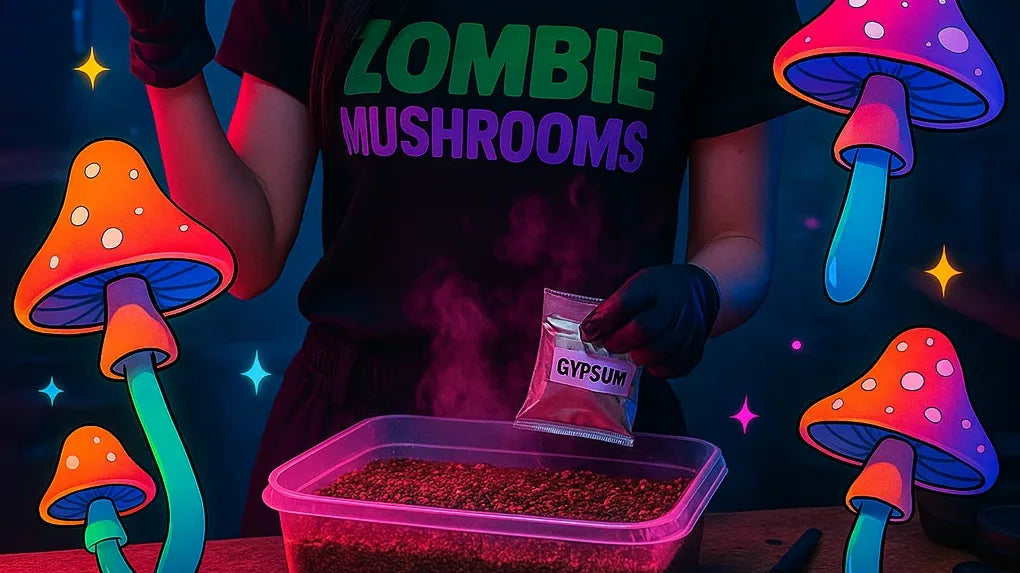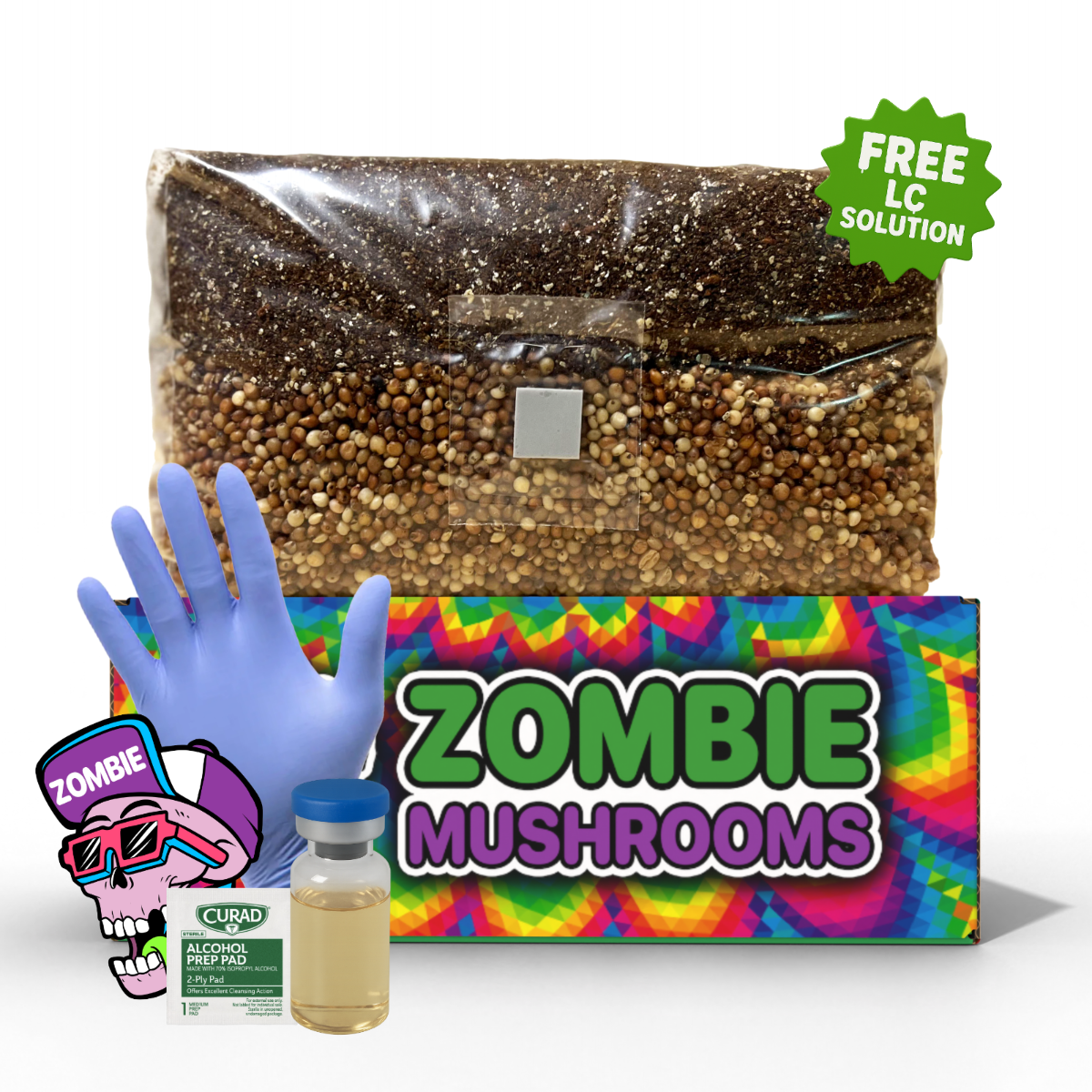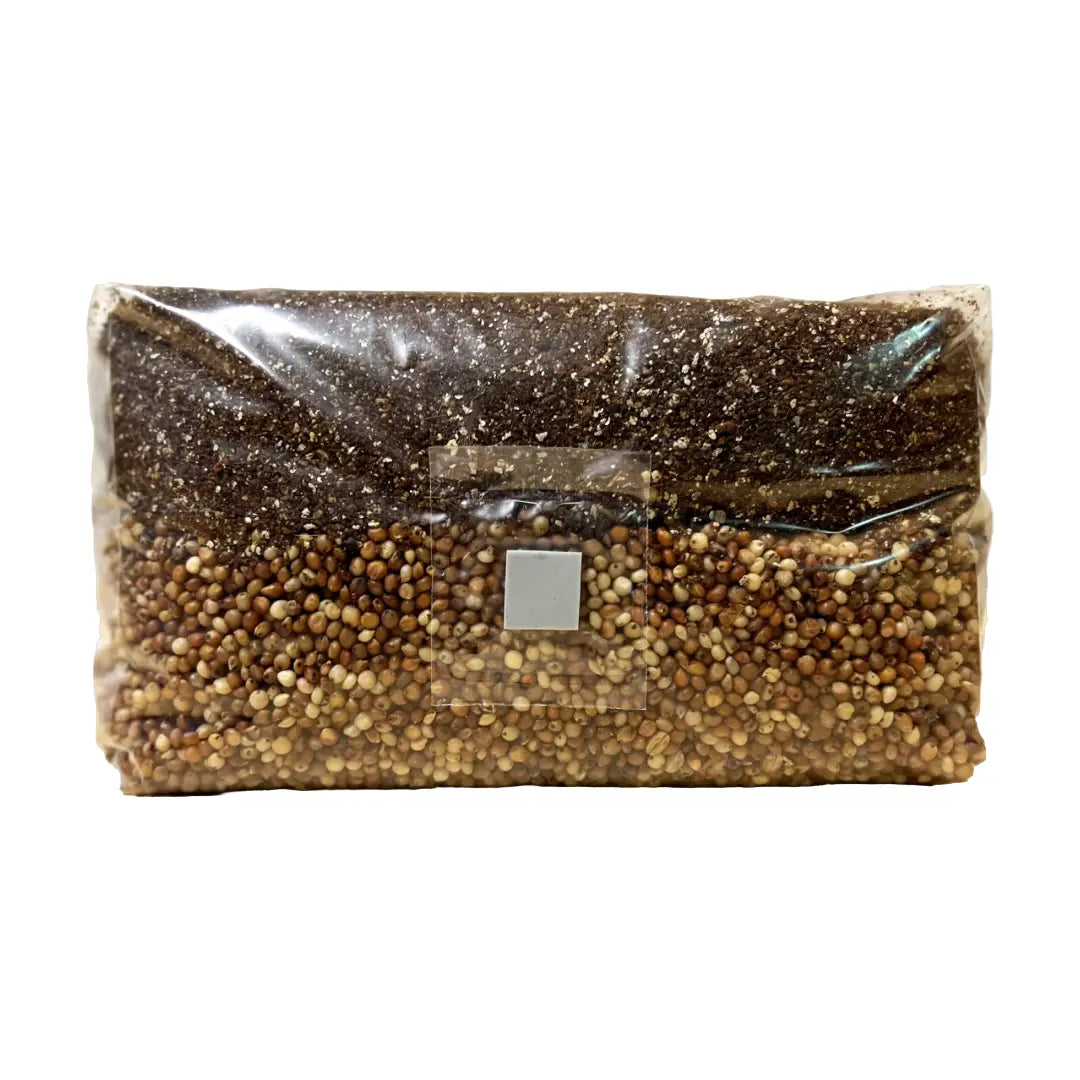⬇️ Prefer to listen instead? ⬇️
- Scientific studies show gypsum speeds up how fast mycelium spreads by up to 18%.
- It gives calcium and sulfur. These are important nutrients for cells to work and make amino acids.
- Gypsum makes grain separate better and improves the substrate texture. This helps mycelium grow better.
- It helps keep the pH steady. This stops the substrate from suddenly becoming too acidic or too alkaline.
- But using too much gypsum or industrial-grade gypsum can harm mushroom crops. This is because it can be toxic or make the substrate too dense.
If you grow mushrooms, whether it's your first time or many times, you have likely heard other growers talk about using gypsum in their substrates. Some say it is something that makes things grow very fast. Others say it is not needed. So what is it all about? This guide will help you understand what gypsum does. It will also show how it affects mushroom growth. And it will tell you if it is needed for your setup or just an extra thing you do not need. Let's get into it. If you want to scale up those results, our monotubs offer roomy, low-maintenance fruiting spaces that work smoothly with gypsum-amended substrates to deliver larger, more consistent harvests.

What Is Gypsum?
Gypsum is a natural mineral made of calcium sulfate dihydrate (CaSO₄·2H₂O). It is mined from the ground. It looks like a fine, white-to-grayish powder that dissolves easily in water. Many know it as something used in building, like drywall or plaster. But gypsum is used differently in farming and mushroom growing.
For growing mushrooms, you must use food-grade or horticulture-grade gypsum. This means it has no industrial binders, resins, or harmful chemicals. These pure types of gypsum make sure mycelium (the root-like part of fungi) can safely touch the substrate. There is no risk of harmful foreign substances.
Important Note: Never use construction-grade gypsum (like drywall dust). It may have harmful things like fiberglass or anti-mold chemicals. Always pick one that says it is for garden or food use.

Why Growers Use Gypsum in Mushroom Substrate
Gypsum does many important things in mushroom growing. This makes it one of the most useful and good additives. It gives important minerals. It also makes the substrate better in how it feels, how living things act in it, and its chemistry.
1. Mineral Supplementation
Gypsum is an easy to get source of two needed nutrients:
- Calcium: It helps cells with many tasks, like keeping cell walls stable and turning on enzymes.
- Sulfur: It is part of important amino acids like cysteine and methionine. Both of these help make mycelium healthy.
These nutrients are especially helpful in substrates that do not have many different things, like pure hardwood sawdust or simple grain mixes.
2. Grain Separation During Sterilization
When you sterilize grains (like rye, millet, or sorghum), high heat can make the grains stick or clump together. This stops air from moving and makes the mycelium spread slowly or unevenly. Adding gypsum stops grains from sticking. It does this by lightly coating them and soaking up extra water.
What happens? You get looser, fluffier grain spawn. This helps mycelium spread faster and more widely.
3. Improved Substrate Texture & Airflow
People often forget about the feel of the substrate. But it is important for mycelium to breathe well. Substrates with gypsum are looser. They hold water without getting too wet or without air. This helps gases move in and out. And this is vital for strong mycelium growth.

Gypsum’s Effect on Mycelium Growth
One of the most studied and well-known good points of gypsum is how it directly affects mycelium growth. This is true especially when the mycelium is spreading. This is when the fungus spreads all through the growing material.
Scientific Evidence
Research by Blanchette et al. (2004) showed that substrates with gypsum had a rate of spreading that was 12–18% faster than those without it. These numbers may change a little based on conditions and mushroom type. But the good point is the same in many studies and grower notes.
Nutrient Mechanism
- Calcium helps control enzymes and build cell walls. It makes the chemical processes that control fungal growth faster.
- Sulfur helps make amino acids and proteins. Both are important for new tissue to grow.
Together, these minerals help mycelium grow stronger and better. This is important for beating out harmful germs and making a strong base for mushrooms to grow.

Gypsum and Substrate pH Balance
One topic people often misunderstand in mushroom growing is how additives affect pH. People often say wrong things about what gypsum does here.
Debunking the pH Myth
A common false idea says that gypsum raises the pH of mushroom substrates. This is not true. Gypsum is pH neutral. Unlike lime or crushed oyster shell (which do raise pH), gypsum acts in a gentler way.
Buffering Capacity
While gypsum does not change pH by itself, it does help keep pH steady when outside things act on it, like:
For very sensitive types of mushrooms, such as Agaricus bisporus, a steady pH area makes things much more even when mycelium spreads and when mushrooms grow.

Water Retention and Nutrient Availability
Another main reason for using gypsum in mushroom substrate is how it affects how well water is held and how nutrients move.
Improved Moisture Management
A good substrate needs to have the right amount of water and air. Too much water slows mycelium growth and causes harmful germs to grow. Too little water dries out the fungi. Gypsum acts like a sponge. It soaks up water when you add it and slowly lets it go as needed. This stops the substrate from getting too wet.
Increased Nutrient Uptake
The calcium that gypsum provides also makes cation exchange better. This is how well the substrate can take in and let out nutrients. This means:
- Faster access to nitrogen and phosphorus
- Mycelium can use nutrients better where it is spreading
- It can handle small changes in nutrients
Simply put, gypsum does not just feed the mycelium. It helps the fungi use the nutrients already in the substrate better.

How to Use Gypsum: Practical Application Methods
You do not need to be a mushroom expert to use gypsum well. The process is simple, but you need to be exact.
For Grain Spawn
- Use: ~1 tablespoon (15g) per 1 quart of dry grain.
- When: Before soaking and sterilizing. Gypsum helps loosen grains and stops clumping after pressure cooking.
- Tip: Mix gypsum into dry grain so it coats each kernel evenly. Water will spread it later.
For Bulk Substrates
- Use: ~5–10% by dry weight.
- Compatibility: Works well with straw, sawdust, coir, and manure-based substrates.
- Method: Mix thoroughly into dry substrate mix before pasteurization or hydration.
Mixing it well is key. Gypsum needs to be spread evenly. If it is not mixed well, you can get uneven spots. This can cause mineral problems or poor pH control.

Best Mushroom Varieties That Respond Well to Gypsum
Some mushroom species get more from added gypsum than others. Here are some types that do well when you add gypsum:
-
Pleurotus spp. (Oyster mushrooms)
They spread fast. They like fluffy substrates with many minerals. This helps them grow very fast. -
Agaricus bisporus (Button, Crimini, Portobello)
They do well with how gypsum controls moisture and keeps pH steady in composted substrates. -
Psilocybe cubensis
They often grow on grain spawn. Gypsum helps speed up spreading and lowers the chance of harmful germs. -
Coprinus comatus (Shaggy mane)
Their unique way of growing does well with gypsum. It makes the texture better and adds sulfur.
Types like shiitake and lion’s mane, especially when grown on logs, may show not as big benefits. But gypsum still adds calcium and may make the texture better in blocks with added things.

Can You Grow Mushrooms Without Using Gypsum?
Yes, and many do. This is true for beginners, growers who want to save money, or those using substrates that are already rich in nutrients.
Situations Where Gypsum Is Less Necessary
- Small-scale PF Tek or cake grows.
- Low-budget experiments.
- Substrates that already have many nutrients (e.g., with coco coir, manure, or spent coffee).
However, for bigger grows or where you use grain spawn, gypsum becomes more and more useful. Not using it might not ruin a grow. But using it can help control more things and make results better.

Common Misconceptions About Using Gypsum
Understanding what gypsum actually does is a big part of knowing what to do. So do not believe these wrong ideas:
-
❌ “Gypsum raises substrate pH.”
It does not. It is neutral, but it helps keep the pH from changing. -
❌ “You can use drywall as a gypsum source.”
Drywall may have glues, fiberglass, and harmful substances. Always use food-grade types. -
❌ “More gypsum means bigger mushrooms.”
Too much gypsum can make the substrate too dense or mess up how it holds water. Start with a small amount.
Knowing what you are doing will always be better than guessing. This is especially true when making the growing conditions just right for mushrooms.

Possible Drawbacks or Risks of Gypsum in Substrate
Gypsum is usually good to use. But it has risks, especially if you do not use it correctly.
Overapplication Risks
- Compacted Substrate: Too much gypsum can lower the amount of air pockets. This can stop mycelium from breathing.
- Unwanted Moisture Locks: It may cause uneven wetness if not mixed evenly.
- Extended Sterilization Time: Thick layers of minerals can make grains warmer, so you need to sterilize them for longer.
Contamination Risk
Using low-quality or industrial gypsum may bring in:
- Harmful chemicals
- Glues or resins
- Particles that do not dissolve and change the substrate's chemistry
Always check the product quality before use. How pure the gypsum is directly affects how safe your grow is and how well it turns out.

Tips for Sourcing Quality Gypsum
For best results, always get your gypsum from good sources. Look for:
- 📦 Packaging that states “food-grade” or “horticulture-grade.”
- 🧪 Labels showing ~23% calcium, 19% sulfate content. This shows it is pure.
- 🌾 A fine powder that is easier to mix and spread.
- 🚫 No dyes, fragrances, or binders.
Online suppliers like Zombie Mushrooms focus on additives for mushrooms. Picking a seller who knows what growers need helps make sure you get clean, steady supplies every time.
Gypsum is not fully needed, but it is a smart choice to use. For growers who want to make spreading faster, get more nutrients, and have looser, more breathable substrates, gypsum is a helpful tool that works. It does not cost much, is easy to use, and is safe when used in small amounts. Whether you are growing oysters in buckets or growing cubensis in large tubs, think of gypsum as a reliable part of your growing tools. Mycelium may not ask for it, but it certainly seems to like it.
Citations
Blanchette, R. M., Abad, A. R., & Foo, J. F. (2004). Use of agricultural gypsum as a beneficial soil amendment and its role in rapid mycelial expansion. Journal of Environmental Quality, 31(1), 298–303.
Royse, D. J., & Beelman, R. B. (2007). Six steps to mushroom farming. The Pennsylvania State University Ag Extension.
Stamets, P. (2000). Growing Gourmet and Medicinal Mushrooms. Ten Speed Press.



